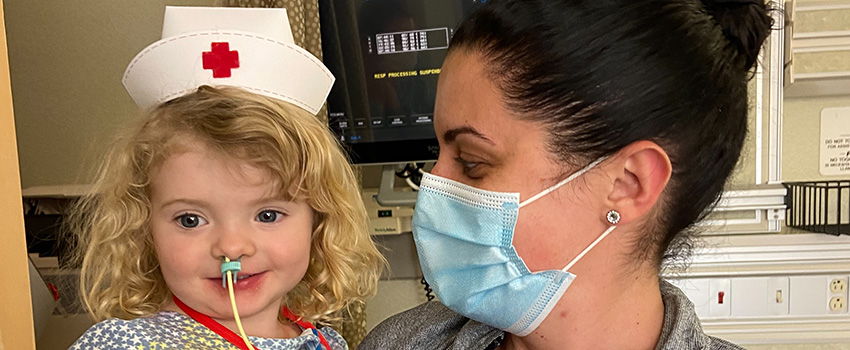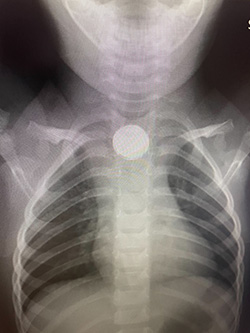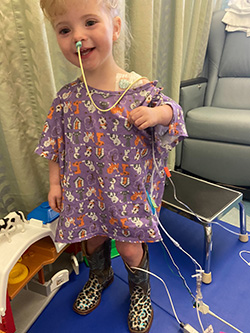Parents’ intuition, St. Luke’s Children’s help save toddler after swallowing button battery

Something wasn’t right with 2-year-old Hadley Dunbar this spring.
She was lethargic and not eating. Something also felt familiar with the way Hadley was behaving and was what her parents had noticed in livestock: Their daughter was choking.
When the Dunbars took Hadley to the doctor’s office, they asked for an X-ray.
Lodged, clear as day, in Hadley’s esophagus was a button battery.
How does a battery get stuck in a child’s throat?

“Kids are quick and impulsive about putting all kinds of random objects in their mouth,” said Whitney Chase, a pediatric ICU nurse practitioner at St. Luke’s Children’s. “Items small enough to choke on are always a concern, what some parents don’t realize is that some of these items, such as button batteries, pose an additional risk.”
According to Safe Kids, more than 2,800 kids are treated in emergency rooms across the U.S. after swallowing button batteries. This year, St. Luke’s Children’s pediatric ICU has taken care of two children with button battery ingestions.
Damage to esophageal tissue begins two hours after it becomes lodged. Leakage of battery contents and the current combine with tissue fluids to create hydroxide at the negative pole of the battery. Symptoms include drooling, regurgitating food, refusal to eat and/or drink, and retching or vomiting.
In Hadley's case, she likely found it in the trash.
“To the best of our knowledge, we had thrown away a battery from a dog’s collar,” said Emily Dunbar, Hadley’s mother. “She was getting in the trash and must have gotten it out of the garbage.”
Since the Dunbars live in eastern Oregon, Hadley was quickly transferred to St. Luke’s Children’s in Boise.
Hadley arrived at Children’s at midnight in late March. For Emily Dunbar, it was the most worrisome night of her life. Shortly after arrival, Drs. Ellen Reynolds and Tyler Burpee took her directly to the operating room to remove the battery and assess the injury to the esophagus. While the injury was extensive, only time would tell what would need to be done in the future.
“They said this isn’t a routine surgery,” Emily Dunbar said. “There is serious damage to the esophagus. The statistics aren’t good on this. Button battery ingestion can become fatal within six hours. Dr. David Klima took over and did great. They made no assumptions, always erring on the side of caution.”

Soon after, the Dunbars had a room at the Ronald McDonald House Charities of Idaho. Hadley spent her first 72 hours at Children’s under sedation. In total, she was there for 27 days. She eventually was transferred to Stanford in California.
Emily Dunbar says the doctors and care staff at Children’s were impressive and their bedside manner was second to none.
The Dunbars said they really appreciated the way everyone spoke to them during a scary, potentially life-or-death situation. In addition to Dr. Klima, the Dunbars wanted to call out Drs. Burpee and Reynolds as well as PICU nurse practitioner Whitney Chase for their efforts.
As for Hadley, she is doing well. Her follow up visits include wearing her favorite article of clothing from her original stay: her boots.
“Hadley always wanted to wear boots,” Emily Dunbar said. “So much so that at Stanford they thought she lost weight. We were like ‘no put the boots on! It’s the same!’”
If you think your child may have ingested a button battery, immediately take them to the emergency department. Time is critical for removal of the battery, as more tissue is damaged the longer it is lodged. Button batteries should be stored out of reach of children and in a locked or difficult to open container. Household items that use button batteries should be kept out of reach as well.
What to know about button batteries and safety tips from Safe Kids:
Button battery information
- Small, lithium coin-sized batteries are often referred to as button batteries
- Common in toys, watches, cameras, games, hearing aids, and even audible greeting cards
- They are flat and shiny batteries and particularly pose serious health risks for kiddos and toddlers
- Their size makes them easy to put in a curious mouth and accidentally swallow
- If swallowed, the button battery may stick in the throat or stomach and cause life-threatening burns and tissue damage as the chemicals leak out
- Severe burns can occur in as little as two hours after swallowing
- The injury is similar to a burn caused by swallowing a chemical drain cleaner
- Active and expired batteries can cause severe injuries if swallowed
- If you suspect a kiddo has swallowed a button battery, seek medical attention right away, even if no symptoms appear
- Do NOT have your child eat or drink to attempt to move the battery
- Symptoms may include coughing, drooling, trouble swallowing, and fever
Safety tips!
- Check your kids' toys and beware of the risks
- Keep all batteries or objects with batteries out of reach and secured away from kids when not supervised
- Get help quickly if you suspect a battery has been swallowed
- Contact the National Button Battery Ingestion Hotline at 800-498-8666 for more information
About The Author

Randall Post works in the Communications and Marketing department at St. Luke’s.


